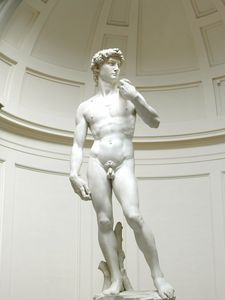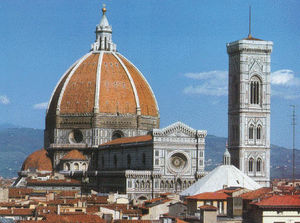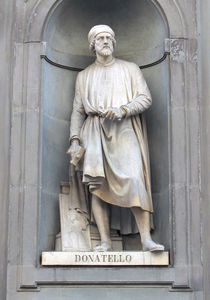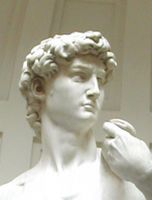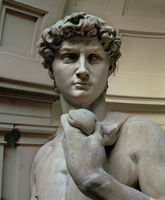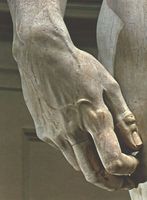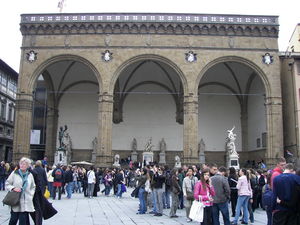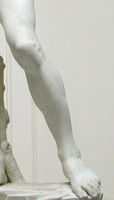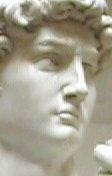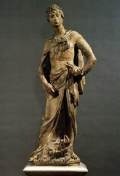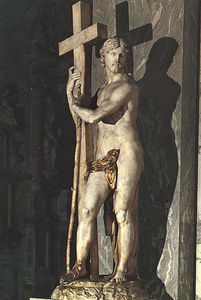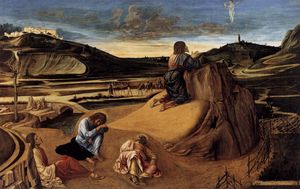David
- Date of Creation:
- 1504
- Height (cm):
- 517.00
- Medium:
- Stone
- Subject:
- Figure
- Art Movement:
- Renaissance
- Created By:
- Current Location:
- Florence, Italy
David Story / Theme
In 1501 Michelangelo was commissioned to create his scultpure David by the city of Florence and it was intended to stand in one of the buttresses of the Florence Cathedral. This had been a project that had been going on for a number of years and Donatello himself had been designing different pieces.
In 1460 the sculptor Agostino di Duccio started working on Donatello's design of David. Using a 17-foot tall piece of marble di Duccio abandoned the commission in 1466, most likely when Donatello passed away. The project was forgotten about until Michelangelo was reassigned the commission in 1501.
The marble piece was far from ideal, already used and shallow in width. However marble was pricey and the city were determined they wanted to use it, so Michelangelo enthusiastically took to the task on the recycled piece of material.
The young, muscular boy David is shown with a slight scowl on his face. Rather unusually, David is represented just before the battle, rather than after, and the sling is rested on his shoulder. David is slightly leant away from the coming threat and the contraction of his stomach muscles and the vain popping in his hand suggests that he is weary about the pending conflict.
The positioning of David was partly influenced by the existing work that di Duccio had done and it was also partly designed so that David would be seen lording over Florence.
Michelangelo wanted to create a piece that would resound with people from a distance. If David had been placed in the Cathedral he would have been raised on a platform in one of the buttresses, seen looking out over the whole city. Thus, Michelangelo made the sculpture with sharp incisions, such as for the face, hair and muscles.
Before Michelangelo had finished the work the city decided that they didn't want to place the sculpture in the Cathedral after all. A panel of judges, consisting of Filippino Lippi, Botticelli, Leonardo da Vinci, Giuliano and Antonio de Sangallo and other citizens of Florence voted on where David would best be placed. Da Vinci wanted David to stand under the arches of the Loggia della Signoria. However it would have been dwarfed under the large edifice and the Sagallo brothers argued against this, saying that David would age better if it was kept away from the elements.
Subsequently it was then agreed that David should be put outside of the Palazzo dei Priori, as a sign of the city's freedom from the Medici.
Before a prudish Florence was happy to showcase Michelangelo's David they produced a copper belt of 28 leaves that would hang around his waist, to cover the nudity of the sculpture. Two months later they spent four days moving Michelangelo's David in front of the Palazzo dei Priori, an important building that housed the electives of the republic, those standing against the Medici rule.
Unfortunately, the positioning of Michelangelo's David meant that the sculpture was attacked with stones by a group of likely Medici supporters. Additionally in 1527, during the third expulsion of the Medici from Florence, a bench was thrown from the building. The bench hit Michelangelo's David and broke its left hand and arm.
In 1873 the sculpture was moved to the Accademia Gallery in Florence to protect it from any more damage and in 1910 a replica was placed in front of the Palazzo dei Priori. Even so in 1991 a mentally unstable man attacked David with a hammer and broke off some marble from his foot.
Michelangelo's David is one of the most famous sculptures in all of Florence, a city known for its wonderful art. Its residents are extremely protective of the statue and they were recently involved in a battle with Rome over the ownership of the piece.
David Inspirations
In 1501 Michelangelo was commissioned by the Frenchman Pierre de Rohan to create a bronze copy of Donatello's bronze David. Rohan had been highly impressed by Donatello's David when he had visited Florence in 1494 and wanted his own version.
However, after being sent to France Michelangelo's bronze David was lost and its whereabouts are still unknown. Nevertheless Michelangelo's drawings still exist of the piece, showing that it was not an exact replica of Donatello's David. Michelangelo had changed some of the detail on the right arm.
That same year Michelangelo was commissioned to create his marble David by the Florentine republic and it's inevitable that he was influenced by his previous assignment, based on Donatello's work.
On Michelangelo's original drawings he wrote on one of his papers "David with his sling and me with my bow (drill), Michelangelo". Michelangelo was inspired by David himself when creating his sculpture. Just as David had overcome the giant Goliath with his stone, he (Michelangelo) was facing his challenges with a drill.
David was a symbol of the republic against the Medici rule, standing tall and brave against the status quo. Thus, just as David had faced Goliath, Michelangelo was looking at the challenges that were coming toward him with regards to his sculpting tools.
David Analysis
Composition:
Michelangelo's David is stood looking over the city of Florence. The sculpture shows the moment after David decided that would fight Goliath, but before he has gone into action. Thus David is shown apprehensively leaning away from Goliath with his sling shot at the ready.
He is a muscled, sinewy figure of about sixteen, with a well-built physique. His stomach muscles are tensely contracted and there is a vain popping in his hand due to the stress of the situation.
David is scowling with a rock ready in his right hand and his sling shot slung over his left shoulder. He is poised and ready to fight against Goliath, although the slant of his body reveals his nervousness.
Texture:
David stands tall at 517 cm and is made of soft marble from the Fantiscritti quarries in Miseglia, Italy. Although Michelangelo was restricted by the work that Agostino di Duccio had already completed on the marble, he finished it brilliantly. There is no sign of the 25 years that the large piece of marble was abandoned and left to the elements outside of Florence Cathedral.
David Critical Reception
During life:
Before Michelangelo had completed his marble David the eager city of Florence had already decided that it deserved to be placed in a location more central than a buttress in the Cathedral. Enthusiastic about the work in progress Leonardo Da Vinci suggested it should be placed in one of the large arch ways of the Loggia della Signoria.
The great Loggia della Signoria was a place where they held important public ceremonies and if Michelangelo's David had been placed here it could have been admired by many. However it was noted that the large arches would dwarf the impressive sculpture and this idea was voted against.
After the Sangallo brothers insisted that the sculpture was kept out of the rain it was eventually decided that David should be placed in front of the Palazzo dei Priori, an important building that stood for the freedom of Florence from the Medici rule.
Although the critical reception of Michelangelo's David was excellent the prudish city rulers did insist that the private parts were covered before it was displayed in public. Thus 28 Golden copper leaves were hung around David's waist to protect the modesty of the Florentine citizens.
After death:
The posthumous critical reception of Michelangelo's David has been as consistently good. Every year tourists flock to Florence and Michelangelo's David is one of its biggest attractions which is impressive considering that Florence is one of the art capitals of the world.
In fact the critical reception of Michelangelo's David has been so great that in recent times there was a battle between Rome and Florence as to who owned the statue. Officially the city of Florence is the owner but people in Rome contested this.
Countless books have been written about Michelangelo's David and numerous replicas have been created. It is one of the most famous artistic images of all time.
David Related Sculptures
David Artist
Michelangelo was an artist from the High Renaissance who was talented in working in sculpture, painting and architecture. Michelangelo became known in Florence at a young age, when Lorenzo the Great saw his sculpture of a faun's head, and he soon began taking commissions.
Michelangelo was a Florentine and in 1501 convinced the city of Florence to give him the commission to make a David from a costly and abandoned piece of marble. Michelangelo's reputation preceded him and thus the David was highly anticipated.
Michelangelo lived to an old age and died whilst working on St. Peter's Basilica. Although he produced different kinds of art he primarily considered himself to be a sculptor. David is one of Michelangelo's most famous and popular pieces in Florence today.
David Art Period
Michelangelo was an artist who worked during the High Renaissance period in Italy. In French the word Renaissance means re-birth, and during this period it referred to the resurrection of the Greek and Roman Classical art work.
Although Michelangelo worked during the High Renaissance, many say that his art triggered the Mannerist movement. However, David is a High Renaissance piece and Michelangelo made it his own by representing David before his fight with Goliath.
The Renaissance period ended in the 1600s and is now known as one of the most prolific eras in art history. Many Renaissance artworks are today considered among the greatest in history.
David Bibliography
For further insight into Michelangelo and his works, please refer to the following recommended sources.
• Amendola, Aurelio & Paolucci, Antonio. Michelangelo's David. Royal Academy: London, 2006
• Falletti, Franca. Michelangelo's David: A Masterpiece Restored. Giunti Editore, 2004
• Graham-Dixon, Andrew. Michelangelo and the Sistine Chapel. Skyhorse Publishing, 1999
• Hartt, Frederick & Wilkins, David. History of Italian Renaissance Art. Laurence King Publishing, 2007
• Mancinelli, Fabrizio. The Sistine Chapel. Edizioni Musei Vaticani, 1995
• Pittaluga, Mary. The Sistine Chapel. University of California, 1965
• Wallace, William. Michelangelo: Selected Scholarship in English. Washington University, 1995
• Hirst , Michael, et al. The Sistine Chapel: a glorious restoration. Abrams, 1999

